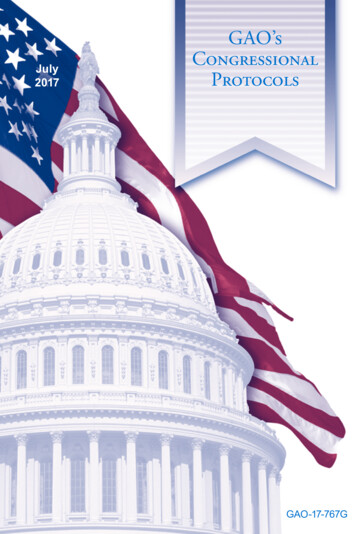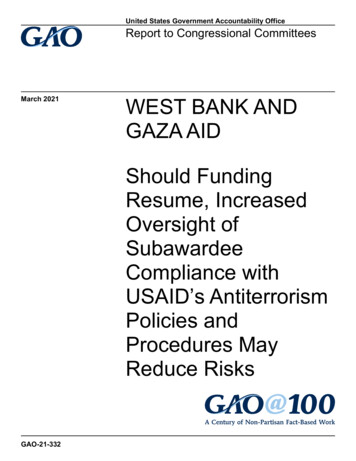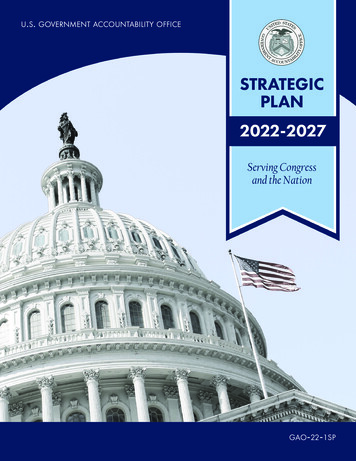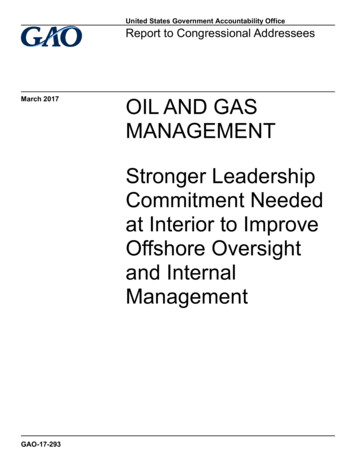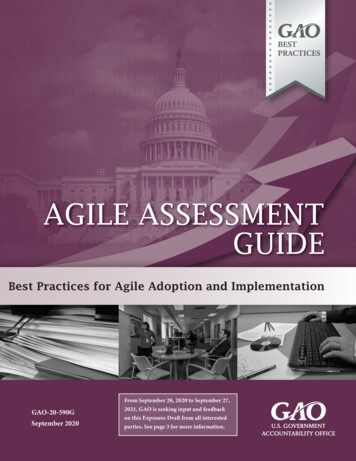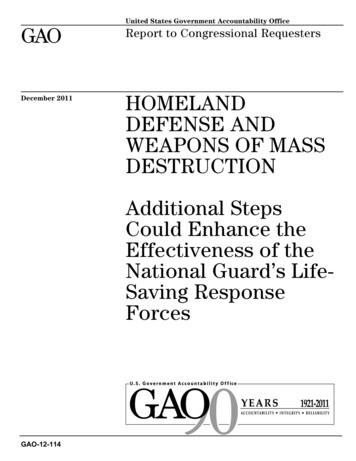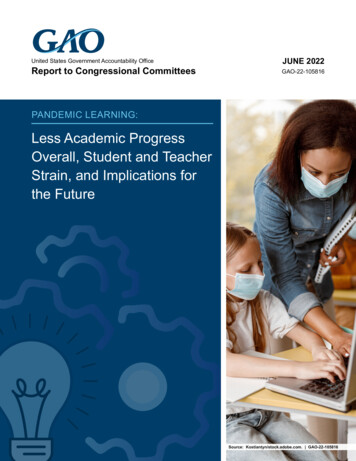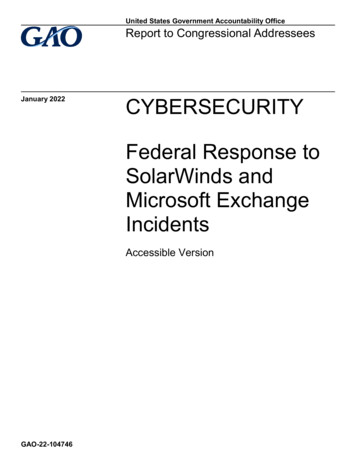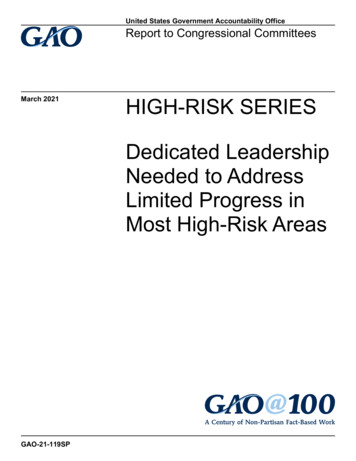
Transcription
United States Government Accountability OfficeReport to Congressional CommitteesMarch 2021HIGH-RISK SERIESDedicated LeadershipNeeded to AddressLimited Progress inMost High-Risk AreasGAO-21-119SP
March 2021HIGH-RISK SERIESDedicated Leadership Needed to Address LimitedProgress in Most High-Risk AreasHighlights of GAO-21-119SP, a report tocongressional committeesWhy GAO Did This StudyWhat GAO FoundThe federal government is one of theworld’s largest and most complexentities; about 6.6 trillion in outlaysin fiscal year 2020 funded a broadarray of programs and operations.GAO’s High-Risk Series identifiesgovernment operations withvulnerabilities to fraud, waste, abuse,and mismanagement, or in need oftransformation to address economy,efficiency, or effectivenesschallenges.Overall ratings in 2021 for 20 of GAO’s 2019 high-risk areas remain unchanged,and five regressed. Seven areas improved, one to the point of removal from theHigh-Risk List. Two new areas are being added, bringing our 2021 High-Risk Listto 36 areas. Where there has been improvement in high-risk areas,congressional actions, in addition to those by executive agencies, have beencritical in spurring progress.This biennial update describes thestatus of high-risk areas, outlinesactions that are still needed to assurefurther progress, and identifies anynew high-risk areas needing attentionby the executive branch andCongress. Solutions to high-riskproblems save billions of dollars,improve service to the public, andstrengthen government performanceand accountability.GAO uses five criteria to assessprogress in addressing high-riskareas: (1) leadership commitment, (2)agency capacity, (3) an action plan,(4) monitoring efforts, and (5)demonstrated progress.What GAO RecommendsThis report describes GAO’s views onprogress made and what remains tobe done to bring about lastingsolutions for each high-risk area.Addressing GAO’s hundreds of openrecommendations across the highrisk areas and continuedcongressional oversight and actionare essential to achieving greaterprogress.View GAO-21-119SP. For more information,contact Michelle Sager at (202) 512-6806 orsagerm@gao.gov.GAO is removing Department of Defense (DOD) Support InfrastructureManagement from the High-Risk List. Among other things, DOD has moreefficiently utilized military installation space; reduced its infrastructure footprintand use of leases, reportedly saving millions of dollars; and improved its use ofinstallation agreements, reducing base support costsGAO is narrowing the scope of three high-risk areas by removing segments ofthe areas due to progress that has been made. The affected areas are: (1)Federal Real Property (Costly Leasing) because the General ServicesAdministration has reduced its reliance on costly leases and improved monitoringefforts; (2) DOD Contract Management (Acquisition Workforce) because DODhas significantly rebuilt its acquisition workforce; and (3) Management of FederalOil and Gas Resources (Offshore Oil and Gas Oversight) because theDepartment of the Interior's Bureau of Safety and Environmental Enforcementhas implemented reforms improving offshore oil and gas oversight.National Efforts to Prevent, Respond to, and Recover from Drug Misuse is beingadded to the High-Risk List. National rates of drug misuse have been increasing,and drug misuse has resulted in significant loss of life and harmful effects tosociety and the economy. GAO identified several challenges in the federalgovernment’s response, such as a need for greater leadership and coordinationof the national effort, strategic guidance that fulfills all statutory requirements, andmore effective implementation and monitoring.Emergency Loans for Small Businesses also is being added. The Small BusinessAdministration has provided hundreds of billions of dollars’ worth of loans andadvances to help small businesses recover from adverse economic impactscreated by COVID-19. While loans have greatly aided many small businesses,evidence of fraud and significant program integrity risks need much greateroversight and management attention.Nine existing high-risk areas also need more focused attention (see table).2021 High-Risk List Areas Requiring Significant AttentionHigh-risk areas that regressed since 2019USPS Financial ViabilityHigh-risk areas that need additional attentionIT Acquisitions and OperationsDecennial CensusEnsuring the Cybersecurity of the NationLimiting the Federal Government’s Fiscal Exposureby Better Managing Climate Change RisksU.S. Government’s Environmental LiabilityStrategic Human Capital ManagementImproving Federal Oversight of Food SafetyEPA’s Process for Assessing and ControllingToxic ChemicalsSource: GAO. GAO-21-119SPUnited States Government Accountability Office
GAO’s 2021 High-Risk ListHigh-risk areaStrengthening the Foundation for Efficiency and EffectivenessStrategic Human Capital ManagementManaging Federal Real PropertyaFunding the Nation’s Surface Transportation Systemb cModernizing the U.S. Financial Regulatory SystembResolving the Federal Role in Housing FinancebUSPS Financial ViabilitybManagement of Federal Oil and Gas ResourcesaLimiting the Federal Government’s Fiscal Exposure by Better Managing Climate Change RisksbImproving the Management of IT Acquisitions and OperationsImproving Federal Management of Programs That Serve Tribes and Their MembersDecennial CensusU.S. Government’s Environmental LiabilitybEmergency Loans for Small Businesses (new)cTransforming DOD Program ManagementDOD Weapon Systems AcquisitionDOD Financial ManagementDOD Business Systems ModernizationDOD Approach to Business TransformationEnsuring Public Safety and SecurityGovernment-wide Personnel Security Clearance ProcessbEnsuring the Cybersecurity of the NationbStrengthening Department of Homeland Security Management FunctionsEnsuring the Effective Protection of Technologies Critical to U.S. National Security InterestsImproving Federal Oversight of Food SafetybProtecting Public Health through Enhanced Oversight of Medical ProductsTransforming EPA’s Process for Assessing and Controlling Toxic ChemicalsNational Efforts to Prevent, Respond to, and Recover from Drug Misuse (new)cManaging Federal Contracting More EffectivelyVA Acquisition ManagementdDOE’s Contract and Project Management for the National Nuclear Security Administration and Office ofEnvironmental ManagementNASA Acquisition ManagementDOD Contract ManagementaAssessing the Efficiency and Effectiveness of Tax Law AdministrationEnforcement of Tax LawsbModernizing and Safeguarding Insurance and Benefit ProgramsMedicare Program & Improper PaymentseStrengthening Medicaid Program IntegritybImproving and Modernizing Federal Disability ProgramsPension Benefit Guaranty Corporation Insurance Programsb cNational Flood Insurance ProgrambManaging Risks and Improving VA Health CarebChange since 2019 n/a n/a n/an/a n/a ( indicates area progressed on one or more criteria since 2019; indicates area declined on one or more criteria; indicates no change; n/a notapplicable)Source: GAO. GAO-21-119SPRatings for a segment within this high-risk area improved sufficiently that the segment was removed.aLegislation is likely to be necessary in order to effectively address this high-risk area.bcNot rated, because this high-risk area is newly added or primarily involves congressional action.Rated for the first time, because this high-risk area was newly added in 2019.dOnly rated on one segment; we did not rate other elements of the Medicare program.e
ContentsLetter1How We Identify and Rate High-Risk AreasChanges to the 2021 High-Risk ListHigh-Risk Areas Have Made Limited Progress OverallHigh-Risk Areas Needing Significant Attention461830Appendix IBackground35Appendix IIOverview for Each High-Risk Area40DOD Support Infrastructure ManagementStrategic Human Capital ManagementManaging Federal Real PropertyFunding the Nation’s Surface Transportation SystemModernizing the U.S. Financial Regulatory SystemResolving the Federal Role in Housing FinanceUSPS Financial ViabilityManagement of Federal Oil and Gas ResourcesLimiting the Federal Government’s Fiscal Exposure by BetterManaging Climate Change RisksImproving the Management of IT Acquisitions and OperationsImproving Federal Management of Programs that Serve Tribesand Their MembersDecennial CensusU.S. Government’s Environmental LiabilityEmergency Loans for Small BusinessesDOD Weapon Systems AcquisitionDOD Financial ManagementDOD Business Systems ModernizationDOD Approach to Business TransformationGovernment-wide Personnel Security Clearance ProcessEnsuring the Cybersecurity of the NationStrengthening Department of Homeland Security ManagementFunctionsEnsuring the Effective Protection of Technologies Critical to U.S.National Security InterestsImproving Federal Oversight of Food SafetyProtecting Public Health through Enhanced Oversight of MedicalProducts4149546369747983Page O-21-119SP High-Risk Series
Transforming EPA’s Process for Assessing and Controlling ToxicChemicalsNational Efforts to Prevent, Respond to, and Recover from DrugMisuseVA Acquisition ManagementDOE’s Contract and Project Management for the National NuclearSecurity Administration and Office of EnvironmentalManagementNASA Acquisition ManagementDOD Contract ManagementEnforcement of Tax LawsMedicare Program & Improper PaymentsStrengthening Medicaid Program IntegrityImproving and Modernizing Federal Disability ProgramsPension Benefit Guaranty Corporation Insurance ProgramsNational Flood Insurance ProgramManaging Risks and Improving VA Health CareAppendix IIIGAO’s 2021 High-Risk ted GAO Products295TablesTable 1: 2021 High-Risk Areas Rated against Five Criteria forRemoval from GAO’s High-Risk ListTable 2: 2021 High-Risk Area Ratings on Five Criteria forRemoval from GAO’s High-Risk ListTable 3: Examples of Congressional Actions Taken on High-RiskAreasTable 4: Examples of GAO High-Risk Area RecommendationsLeading to Financial BenefitsTable 5: Changes to the High-Risk List, 1990-2021Table 6: Examples of Skills Gaps Related to High-Risk AreasTable 7: Percent of Executive Branch Agencies That MetTimeliness Objectives for the Fastest 90 Percent ofSecurity Clearances, Fiscal Years 2018 – 2020Table 8: GAO Assessment of DHS Progress in Addressing KeyOutcomesTable 9: GAO’s 2021 High-Risk ListPage ii192226293551165180293GAO-21-119SP High-Risk Series
FiguresFigure 1: Illustrative Example of High-Risk Progress CriteriaRatingsFigure 2: Rate of Drug Overdose Deaths in the United States,2002–2019Figure 3: High-Risk Areas’ Progress and Regress on High-RiskCriteria Since 2019Figure 4: Criteria for Removal from the High-Risk List andExamples of Actions Leading to ProgressFigure 5: History of Areas Removed from the High-Risk ListFigure 6: History of Areas Added to the High-Risk List, by YearFigure 7: Projected Cumulative Highway Trust Fund Balance,Fiscal Years 2021 through 2030Figure 8: U.S. Government’s Environmental Liability, Fiscal Years2015-19Figure 9: Ten Critical Actions Needed to Address Four MajorCybersecurity ChallengesFigure 10: Pension Benefit Guaranty Corporation’s (PBGC) NetFinancial Position of the Single-Employer andMultiemployer Programs Combined, Fiscal Years 2000through 2020692137383964125174277This is a work of the U.S. government and is not subject to copyright protection in theUnited States. The published product may be reproduced and distributed in its entiretywithout further permission from GAO. However, because this work may containcopyrighted images or other material, permission from the copyright holder may benecessary if you wish to reproduce this material separately.Page iiiGAO-21-119SP High-Risk Series
Letter441 G St. N.W.Washington, DC 20548March 2, 2021The Honorable Gary C. PetersChairmanThe Honorable Rob PortmanRanking MemberCommittee on Homeland Security and Governmental AffairsUnited States SenateThe Honorable Carolyn B. MaloneyChairwomanThe Honorable James ComerRanking MemberCommittee on Oversight and ReformHouse of RepresentativesSince the early 1990s, our high-risk program has focused attention ongovernment operations with greater vulnerabilities to fraud, waste, abuse,and mismanagement, or that are in need of transformation to addresseconomy, efficiency, or effectiveness challenges. This effort, supportedby the Senate Committee on Homeland Security and GovernmentalAffairs and by the House of Representatives Committee on Oversight andReform, has brought much needed attention to problems impedingeffective government and costing billions of dollars each year.We have made hundreds of recommendations to reduce thegovernment’s high-risk challenges. Executive agencies either haveaddressed or are addressing many of them and, as a result, progress isbeing made in a number of areas.Congress also continues to take important actions. For example,Congress has enacted a number of laws in recent years that are helpingto make progress on high-risk issues. Financial benefits to the federalgovernment due to progress in addressing high-risk areas over the past15 years (fiscal year 2006 through fiscal year 2020) totaled nearly 575billion or an average of about 38 billion per year. Since our last update in2019, we recorded approximately 225 billion in financial benefits. 11Financialbenefits are based on actions taken in response to our work, such as reducinggovernment expenditures, increasing revenues, or reallocating funds to other areas.Page 1GAO-21-119SP High-Risk Series
Nonetheless, substantial efforts are needed on high-risk areas to achievegreater progress and to address regression in some areas since the lasthigh-risk update in 2019. Tens of billions of dollars in additional benefitsand substantial improvements to the health, well-being, and security ofthe nation would be achieved by fully addressing high-risk issues.Sustained congressional attention and executive branch leadershipremain key to success.The nation faces unprecedented challenges that require the federalgovernment to perform better, be more responsive to the Americanpeople, and achieve greater results. Major issues facing the nationinclude the Coronavirus Disease 2019 (COVID-19) pandemic, economicdownturns and the federal response, race in America, and the federalgovernment’s ability to meet these and other strategic challenges andperform better. 2 Concerted action on High-Risk List areas is vital to buildthe capacity of the federal government and make progress on the currentand emerging challenges facing the nation.We are issuing this year’s High-Risk Report while the federal governmentand the country continue to respond to and recover from the COVID-19pandemic. In addition to catastrophic loss of life, the pandemic hascaused substantial damage to the economy, with many peopletemporarily or permanently unemployed. Moreover, the surge in casesthis winter has overwhelmed the health care system in multiple areasacross the country.The CARES Act includes a provision for us to conduct monitoring andoversight of the federal government’s efforts to prepare for, respond to,and recover from the COVID-19 pandemic. 3 As of January 2021, we hadissued six reports in response to this provision, made 44recommendations to federal agencies, and raised four matters forcongressional consideration to improve the federal government’s2Wealso highlight our work on these issues on our Presidential and CongressionalTransition website at https://www.gao.gov/presidential and congressional transition/.3Pub.L. No. 116-136, § 19010, 134 Stat. 281, 579-81 (2020).Page 2GAO-21-119SP High-Risk Series
response efforts. 4 Agencies agreed with some of these recommendationsand disagreed with others. We maintain that all our recommendations arewarranted. We also have other work under way that addresses thegovernment’s response and recovery activities. 5We urge Congress and the administration to take swift action inimplementing these recommendations and matters. We will continue toprovide ongoing oversight of the federal government’s pandemicresponse and recovery efforts. This report discusses the Department ofHealth and Human Services’ (HHS) leadership and coordination of publichealth emergencies as an emerging issue meriting close attention.COVID-19 has particularly affected several areas on the High-Risk List,including the Decennial Census, Protecting Public Health throughEnhanced Oversight of Medical Products, Improving and ModernizingFederal Disability Programs, Enforcement of Tax Laws, and others. Theeffects of COVID-19 on individual high-risk areas are discussed further inappendix II, where we discuss the status of each high-risk area.This report describes (1) progress made addressing high-risk areas andthe reasons for that progress, and (2) actions that are still needed. It alsoidentifies two new high-risk areas—National Efforts to Prevent, Respondto, and Recover from Drug Misuse and Emergency Loans for SmallBusinesses—and one high-risk area we removed from the list because itdemonstrated sufficient progress in managing risk—Department ofDefense (DOD) Support Infrastructure Management.4GAO,COVID-19: Critical Vaccine Distribution, Supply Chain, Program Integrity, andOther Challenges Require Focused Federal Attention, GAO-21-265 (Washington, D.C.:Jan. 28, 2021); COVID-19: Urgent Actions Needed to Better Ensure an Effective FederalResponse, GAO-21-191 (Washington, D.C.: Nov. 30, 2020); COVID-19: Federal EffortsAccelerate Vaccine and Therapeutic Development, but More Transparency Needed onEmergency Use Authorizations, GAO-21-207 (Washington D.C.: Nov. 17, 2020); COVID19: Federal Efforts Could Be Strengthened by Timely and Concerted Actions,GAO-20-701 (Washington, D.C.: Sep. 21, 2020); COVID-19: Brief Update on InitialFederal Response to the Pandemic, GAO-20-708 (Washington, D.C.: Aug. 31, 2020); andCOVID-19: Opportunities to Improve Federal Response and Recovery Efforts,GAO-20-625 (Washington, D.C.: June 25, 2020).5For more information on our ongoing review of the federal response to the COVID-19pandemic and oversight of related spending, see https://www.gao.gov/coronavirus/.Page 3GAO-21-119SP High-Risk Series
This report is based primarily on reports we had issued as of mid-January2021.How We Identify andRate High-Risk AreasTo determine which federal government programs and functions shouldbe designated high risk, we use our guidance document, DeterminingPerformance and Accountability Challenges and High Risks. 6We consider qualitative factors, such as whether the risk involves public health or safety, service delivery, national security,national defense, economic growth, or privacy or citizens’ rights, or could result in significantly impaired service; program failure; injury orloss of life; or significantly reduced economy, efficiency, oreffectiveness.We also consider the exposure to loss in monetary or other quantitativeterms. At a minimum, 1 billion must be at risk, in areas such as the valueof major assets being impaired; revenue sources not being realized;major agency assets being lost, stolen, damaged, wasted, orunderutilized; potential for, or evidence of, improper payments; andpresence of contingencies or potential liabilities.Before making a high-risk designation, we also consider correctivemeasures planned or under way to resolve a material control weaknessand the status and effectiveness of these actions.Our experience has shown that the key elements needed to makeprogress in high-risk areas are top-level attention by the administrationand agency leaders grounded in the five criteria for removal from theHigh-Risk List, as well as any needed congressional action. The fivecriteria for removal are as follows: Leadership commitment. Demonstrated strong commitment and topleadership support. Capacity. Agency has the capacity (i.e., people and resources) toresolve the risk(s). Action plan. A corrective action plan exists that defines the rootcause and solutions and provides for substantially completing6GAO,Determining Performance and Accountability Challenges and High Risks,GAO-01-159SP (Washington, D.C.: November 2000).Page 4GAO-21-119SP High-Risk Series
corrective measures, including steps necessary to implementsolutions we recommended. Monitoring. A program has been instituted to monitor andindependently validate the effectiveness and sustainability ofcorrective measures. Demonstrated progress. Ability to demonstrate progress inimplementing corrective measures and in resolving the high-risk area.We add clarity and specificity to our assessments by rating each high-riskarea’s progress on the five criteria and use the following definitions: Met. Actions have been taken that meet the criterion. There are nosignificant actions that need to be taken to further address thiscriterion. Partially met. Some, but not all, actions necessary to meet thecriterion have been taken. Not met. Few, if any, actions toward meeting the criterion have beentaken.Figure 1 shows a visual representation of varying degrees of progress ineach of the five criteria for a high-risk area. Each point of the starrepresents one of the five criteria for removal from the High-Risk List andeach ring represents one of the three designations: not met, partially met,or met.An unshaded point at the innermost ring means that the criterion has notbeen met, a partially shaded point at the middle ring means that thecriterion has been partially met, and a fully shaded point at the outermostring means that the criterion has been met. Further, a plus symbol insidethe star indicates the rating for that criterion progressed since our lasthigh-risk update. Likewise, a minus symbol inside the star indicates therating for that criterion declined since our last update.Page 5GAO-21-119SP High-Risk Series
Figure 1: Illustrative Example of High-Risk Progress Criteria RatingsSome high-risk areas are made up of segments or subareas that make upthe overall high-risk area. For example, the high-risk area ProtectingPublic Health through Enhanced Oversight of Medical Products includestwo segments—Response to Globalization and Drug Availability—toreflect two interrelated parts of the overall high-risk area.Multidimensional high-risk areas such as these have separate ratings foreach segment as well as a summary rating of the overall high-risk areathat reflects a composite of the ratings received under the segment foreach of the five high-risk criteria. High-risk areas that are primarily basedon the need for congressional action are not rated on the criteria and donot receive a star graphic.Changes to the 2021High-Risk ListDOD Support Infrastructure Management is being removed from the listdue to the progress that was made in addressing the issue. As we havewith areas previously removed from the High-Risk List, we will continue tomonitor this area to ensure that the improvements we have noted aresustained. If significant problems again arise, we will consider reapplyingthe high-risk designation.As discussed below, we added two areas to the High-Risk List since our2019 update: National Efforts to Prevent, Respond to, and Recover fromDrug Misuse; and Emergency Loans for Small Businesses.Page 6GAO-21-119SP High-Risk Series
In addition to specific areas that we have designated as high risk, otherimportant challenges facing our nation merit continuing close attention.One of these is HHS’s leadership and coordination of public healthemergencies. Another challenge is the management of the federal prisonsystem, including programs that help inmates prepare for a successfulreturn to the community.DOD SupportInfrastructureManagement Removedfrom the High-Risk ListWe are removing the DOD Support Infrastructure Management high-riskarea as DOD has addressed the remaining actions and outcomes fromour 2019 High-Risk Report. For example, under an Office of Managementand Budget (OMB) program to restrict the growth of excess orunderutilized federal properties, DOD contributed to reductions of 68percent of total government-wide office and warehouse space and 75percent of other government-wide properties.DOD also reduced base support costs by implementing our October 2018recommendations to monitor and evaluate use of intergovernmentalsupport agreements between military installations and local governments.In addition, DOD more efficiently utilized installation space through itsreduction of leases, reportedly saving millions of dollars. For example, theArmy reduced its leased footprint in the National Capital Region from apeak of 3.9 million square feet in 2011 to roughly 1 million square feet asof September 2019.DOD is also well positioned for the future to continue improving itssupport infrastructure management as it formally committed in October2019 to implement our remaining recommendations related to future BaseRealignment and Closure rounds. These recommendations included fullyidentifying the cost requirements for military construction, informationtechnology (IT), and relocating personnel and equipment.DOD continues to correct identified real property data discrepancies byissuing new requirements and processes. For example, the Air Force hasestablished a data quality program with a goal of 100 percent accuracy bySeptember 2023, which will help make further improvements to accuracyand completeness of its data moving forward.While we are removing DOD Support Infrastructure from the High-RiskList, it does not mean DOD has addressed all risk within this area. Itremains important that senior leaders continue their efforts to aligninfrastructure with the needs of the forces. Therefore, we will continue toexamine DOD’s efforts, including improving the completeness andPage 7GAO-21-119SP High-Risk Series
accuracy of its real property data as part of our high-risk areas onManaging Federal Real Property and DOD Financial Management.See appendix II for additional detail on this high-risk area.National Efforts to Prevent,Respond to, and Recoverfrom Drug Misuse Addedto the High-Risk ListDrug misuse—the use of illicit drugs and the misuse of prescriptiondrugs—has been a persistent and long-standing public health issue in theUnited States. Ongoing efforts seek to address drug misuse througheducation and prevention, substance use disorder treatment, lawenforcement and drug interdiction, and programs that serve populationsaffected by drug misuse. These efforts involve federal, state, local, andtribal governments as well as community groups and the private sector.Drug misuse represents a serious risk to public health. It has resulted insignificant loss of life and harm to society and the economy. In recentyears, the federal government has spent billions of dollars and hasenlisted more than a dozen agencies to address drug misuse and itseffects.We determined in March 2020 that this issue is high risk. At that time, inconsideration of the challenges from the onset of the COVID-19pandemic, we reported we would be making the high-risk designationeffective in 2021. We also noted that the public health and economiceffects from the COVID-19 pandemic could fuel contributing factors ofdrug misuse, such as unemployment.In December 2020, the Centers for Disease Control and Prevention(CDC) reported, based on its analysis of National Center for HealthStatistics provisional data, that the largest recorded increase of drugoverdose deaths occurred during the 12-month period ending in May2020. In particular, CDC reported a concerning acceleration of theincrease in drug overdose deaths from March 2020 to May 2020,coinciding with the implementation of widespread mitigation measures forthe COVID-19 pandemic.Even before the COVID-19 pandemic, rates of drug misuse hadincreased from 2002 through 2019, and the rates of drug overdosedeaths had also generally increased nationally from the early 2000sthrough 2019. Although the rate of drug overdose deaths in 2018decreased compared to 2017, this improvement was reversed in 2019, asshown in figure 2.Page 8GAO-21-119SP High-Risk Series
Figure 2: Rate of Drug Overdose Deaths in the United States, 2002–2019Note: CDC adjusts drug overdose death rates for age and the population size to control for thechanging age distribution and size of the population, and thereby allows comparisons of rates overtime. Data are not yet available for all of 2020. However, in December 2020, CDC reported, based onits analysis of National Center for Health Statistics provisional data, that the largest recorded increaseof drug overdose deaths occurred during the 12-month period ending in May 2020.The Office of National Drug Control Policy (ONDCP) is responsible foroverseeing and coordinating the implementation of U.S. drug controlpolicy, including developing the National Drug Control Strategy (Strategy).ONDCP produced the Strategy in 2019 and 2020, but neither iterationcontained all the elements required by law. For example, the 2020Strategy did not include the required 5-year projection for the NationalDrug Control Program and budget priorities. It also did not includeestimates of federal funding or other resources needed to achieve each ofthe Strategy’s long-range quantifiable goals.Furthermore, in November 2020, we found that the 2020 National DrugControl Assessment, a companion document to the Strategy, did notinclude complete information on performance measures for a number ofprograms related to the Strategy’s prevention goals. Across our body ofwork, we have made recommendations to ONDCP and other NationalDrug Control Program agencies to help ensure that future iterations of theStrategy include all statutorily required elements and to ensure effective,Page 9GAO-21-119SP High-Risk Series
sustained implementation of the Strategy. Agencies have generallyagreed with our recommendations.Our past work also found that the federal government has faced barriersto in
Strategic Human Capital Management Improving Federal Oversight of Food Safety EPA's Process for Assessing and Controlling Toxic Chemicals . Source: GAO. GAO-21-119SP . View GAO -21 119SP. For more information, contact Michelle Sager at (202) 512-6806 or sagerm@gao.gov. Why GAO Did This Study
